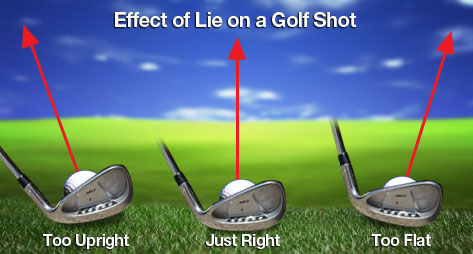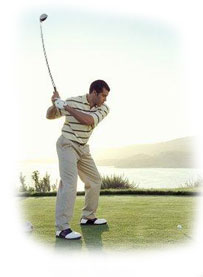How Club Fitting Variables Effect Our Games
How Does Club Length Effect Your Shot?
The longer the club, the more club head speed generated and the farther the ball can go. The trade-off is accuracy.
With a long club it’s harder to hit the ball with the center of the club face…the sweet spot. That’s one of the reasons a driver is harder to hit than a 7 iron. The two main factors in distance and accuracy are swing speed and on-center hits. A ball that is hit off-center will not go as far or as straight. So choosing a club length that is optimum for your height, arm length and ability is very important to good golf.

Getting the correct length for you requires not only measuring your height but also your arm length. A tall golfer with long arms might require the same length club as a shorter golfer with very short arms. The standard method to measure arm length is a wrist-to-floor-measurement (take your shoes off please).
Club length will also affect the swing weight of a golf club. The shorter the club the lighter it will feel. This may be a good thing for players that have less strength. However, it can make the club feel too light for stronger players. If you decide to shorten your club compared to “standard” it’s probably a good idea not to go overboard. One inch should do it.
How Does Lie Effect Your Shot?
Club length directly effects lie angle. A tall golfer generally needs longer clubs, but because that club is longer the lie may need to be adjusted. Ideally we want the sole of the club to lie flat on the ground at impact. If the toe is up, the ball will tend to go left. If the heel is up the ball will tend to go right. If the lie is far off the ball can go as much as 20 yards off line.
Determining your correct lie is dependent on two factors. Your height and arm length measurement and your swing plane. Short people need a flatter lie and tall people generally need a more upright lie. But two people with the same height could require different lie adjustments. If you have an upright swing plane (you tend to swing more over your head) you will need a more upright lie angle. If you have a flat swing plane (tend to swing more behind and around your body) you’ll require a flatter lie angle.

Lie adjustments are made by bending the clubhead at the hosel. Any good clubfitter with the proper equipment should be able to handle this adjustment.
How Does Loft Effect Your Shot?
More loft makes the ball go higher and shorter. But did you ever wonder why your 9 iron seems to go straighter than your 5 iron. It’s a simple truth that the more loft the more accurate our shots will be. Higher loft imparts more backspin which means side spin has less of an effect. Therefore the ball goes straighter and higher.
There is no standard loft for clubs across manufacturers. Everyone creates their own standard and sometimes it even varies across models. For example, the TaylorMade r7 XD (their club for higher handicaps) has a 5 iron loft of 23 degrees. Their club for advanced players, the rac Forged TP has a 5 iron loft of 28 degrees.
Loft Changes By Manufacturers
| Club | Loft Now | Loft in 80s | Woods | Loft | Loft in 80s | |
| 2 | 18-20 | 1 | 9-12 | 7-10 | ||
| 3 | 20-21 | 3 | 13-14 | 15 | ||
| 4 | 23-24 | 26 | 5 | 17-18 | 21 | |
| 5 | 26-27 | 30 | 7 | 20-21 | 27 | |
| 6 | 30-31 | 34 | 9 | 23-26 | NA | |
| 7 | 34-35 | 38 | ||||
| 8 | 38-40 | 42 | ||||
| 9 | 42-44 | 46 | ||||
| PW | 46-48 | 50 | ||||
| GW | 50-52 | NA | ||||
| SW | 55-56 | 56 | ||||
| LW | 58-62 | NA |
The fact that manufacturers have lowered lofts over the last 20 years means your new irons may be harder to hit than your old ones. It also means that there is probably a gap between your pitching wedge and your sand wedge (they didn’t change sand wedge lofts). You may want to consider a “gap” wedge as an additional club. In the eighties a pitching wedge had a loft of about 50 degrees. Today 44-46 degrees is the typical loft. The standard sand wedge didn’t change and is still 56 degrees. A gap wedge fills the void left by the difference between your PW and your SW. If you can choose the loft of your sand wedge, you may want to consider 52 or 54 degrees instead of the traditional 56 degrees. At any rate knowing your lofts can help configure your set correctly.
Driver loft is something that has also changed, but in the opposite direction. Through Launch Monitor testing manufacturers have realized that with today’s low spinning balls, more loft is actually better. Launching the ball at higher angles produces more distance, particularly for slower swing speeds.
How Does Shaft Flex Effect Your Shot?
The shaft is designed to transfer the energy created by the back swing to the ball. That potential energy created by the back swing needs to be unloaded at the exact right time for optimal distance and accuracy. An early unload or release will make the ball go high and to the left and a late release will cause it to go low and to the right. Shaft flex is a major factor in that loading and unloading. A shaft that is too soft for our particular swing speed will cause an early release and a shaft that is too stiff will cause a late release. In both cases swing speed and accuracy will be lost.
Available shaft flexes include…
- (X) extra stiff (swing speed over 125 mph)
- (S) stiff (swing speed 100-25)
- (F) firm (swing speed 90-100)
- (R) regular (swing speed 85-95)
- (A) amateur or senior (75-85)
- (L) ladies (65-75)
For swing speeds lower than 65 mph (many women and juniors) there really is no correct shaft available yet. Someday soon we hope. If you don’t know your swing speed, you can get a good idea by knowing your driver carry distance.
The problem for most beginners or part-time golfers is they may not know how far they hit their drives. Plus their shots can be very inconsistent. So how do you judge your swing speed in that case?
You may want to ask your playing partners or the pro at the range to make a best guess for you. A good estimate, might be this: An average male with a good swing should be able to hit their driver 200-225 yards. A senior male, between 150-175 yards. Woman and juniors, 125-150 yards.
Here’s some approximates distances and how they translate into swing speed and correct shafts.
|
Carry Distance
|
Swing Speed
|
Shaft Flex
|
|
125-150
|
65-75
|
L (ladies)
|
|
150-175
|
75-85
|
A (senior)
|
| 175-200 | 85-95 | R (regular) |
| 200-225 | 95-100 | F (firm) |
| 225-250 | 100-110 | S (stiff) |
| 250-275 | 110-125 | S (stiff) |
| 275+ | 125+ | X (extra stiff) |
What about graphite shafts?
The benefit of graphite shafts is they are lighter so you can swing them faster. Graphite is a good idea for any of the distance clubs – driver, woods, long hybrids. Graphite is also a good idea if you have a slow swing speed like seniors, women and juniors. ![]()
Graphite also offers a softer feel and less contact vibration. Steel shafts are better for faster swing speeds and for the accuracy clubs like irons and particularly wedges. Graphite shafts are available in the full range of flexes and bend points.
How Does Bend Point Effect Your Shot?
The bend point of a club shaft (sometimes called kick or flex point) effects the point of release of the clubhead. Folks who need more height on their shots may want a lower (closer to the head) bend point. Higher club head speeds would want a higher bend point. Once again the goal is to deliver that clubhead at the optimum point with the most speed and accuracy.
Shafts with varying bend points are available but are not easy to find in off-the-rack clubs. UST and Graffalloy make shafts that offer various flexes and bend points.
How Does Swing Weight Effect Your Shot?
The swing weight of a golf club is a measurement of how heavy a club feels. It is not the total dead weight of the club, which is the combined weight of the head, shaft, and grip. It is rather the balance between all three at a fulcrum point along the shaft.
Swing weight measurement is shown in a letter/number scale from A1 to G9, lighter to heavier. D1 is the standard men’s weight and C5 is the standard women’s. The perception as you go up in weight is that the clubhead is heavier. This can be a good thing if you like to have a clear feeling for the clubhead when you swing. However, if the swing weight gets too heavy it can start to slow your swing down. So a balance between not too heavy and not too light is important. The most important factor is consistency. You want to make sure all your clubs feel about the same.
Putter Fitting
Putter fitting is just as important as any other club…maybe more important. After all, we use our putters more than twice as much as any other club.
Variables in putter fitting involve static fitting options like height and arm length but also involve many personal fitting selections like putter alignment preferences and your stroke type. If you tend to stand tall at address you may need a more upright, longer putter than if you tended to bend over. If you tend to extend your arms you may need a shorter putter. It’s a very personal thing.
Loft is also an important parameter for your putter. Most putters have between 3 and 5 degrees of loft. The loft will effect how the ball comes off the putter and how long the ball skids before it starts its true roll. If you tend to play on slow greens with long grass you may want more loft to get the ball up on top of the grass and rolling smoothly.
Still most choices for putters involve feel. Only you can tell if a putter feels right to you. So sooner or later you need to try a bunch of putters to see what you like. You can choose between blade style putters with perimeter weighting and mallet style putters with enhanced moments of inertia (resistence to twisting). The choice and the feel are up to you.

